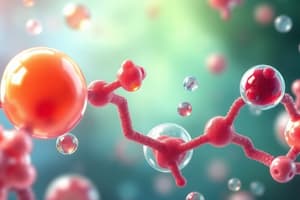Podcast
Questions and Answers
What is a key function of D-Ribose in the body?
What is a key function of D-Ribose in the body?
- Structural component of RNA (correct)
- Energy storage in adipose tissues
- Source of calcium in bones
- Precursor for glucose metabolism
Which monosaccharide is known as fruit sugar?
Which monosaccharide is known as fruit sugar?
- D-Galactose
- D-Glucose
- D-Fructose (correct)
- D-Ribose
What is the normal blood glucose level range?
What is the normal blood glucose level range?
- 120-140 mg/dl
- 60-80 mg/dl
- 70-100 mg/dl (correct)
- 100-130 mg/dl
How can D-Galactose be primarily obtained?
How can D-Galactose be primarily obtained?
Which statement correctly describes 2-Deoxy D-Ribose?
Which statement correctly describes 2-Deoxy D-Ribose?
What is D-Fructose derived from commercially?
What is D-Fructose derived from commercially?
Which of the following describes the origin of D-Glucose?
Which of the following describes the origin of D-Glucose?
What is the role of D-Galactose in the human body?
What is the role of D-Galactose in the human body?
What type of isomerism occurs between glucose and fructose?
What type of isomerism occurs between glucose and fructose?
What characteristic defines stereoisomers?
What characteristic defines stereoisomers?
Which carbon atom is designated as the anomeric carbon in glucose?
Which carbon atom is designated as the anomeric carbon in glucose?
Which type of isomerism involves D- and L- enantiomers?
Which type of isomerism involves D- and L- enantiomers?
What is formed when a cyclic structure has an aldehyde functional group?
What is formed when a cyclic structure has an aldehyde functional group?
Which of the following represents a form of structural isomerism?
Which of the following represents a form of structural isomerism?
Which of the following statements accurately describes monosaccharides?
Which of the following statements accurately describes monosaccharides?
What distinguishes anomerism from other types of stereoisomerism?
What distinguishes anomerism from other types of stereoisomerism?
What type of carbon atom is required for a molecule to be classified as a stereoisomer?
What type of carbon atom is required for a molecule to be classified as a stereoisomer?
Which of the following monosaccharides is classified as a hexose?
Which of the following monosaccharides is classified as a hexose?
What type of saccharide is formed when two monosaccharides join together?
What type of saccharide is formed when two monosaccharides join together?
Which of the following is a correct pair of aldose and ketose monosaccharides based on their number of carbon atoms?
Which of the following is a correct pair of aldose and ketose monosaccharides based on their number of carbon atoms?
Identify the correct straight chain representation of glucose.
Identify the correct straight chain representation of glucose.
What maximum number of monosaccharides can form oligosaccharides?
What maximum number of monosaccharides can form oligosaccharides?
How are monosaccharides primarily categorized based on their functional groups?
How are monosaccharides primarily categorized based on their functional groups?
Which of the following statements regarding carbon atom number in monosaccharides is true?
Which of the following statements regarding carbon atom number in monosaccharides is true?
Which of the following best describes the definition of biochemistry?
Which of the following best describes the definition of biochemistry?
Which biomolecules are classified as carbohydrates?
Which biomolecules are classified as carbohydrates?
What is the general formula for carbohydrates?
What is the general formula for carbohydrates?
Which type of carbohydrate consists of 1 unit?
Which type of carbohydrate consists of 1 unit?
What is true about the ratio of hydrogen to oxygen in carbohydrates?
What is true about the ratio of hydrogen to oxygen in carbohydrates?
Which of the following is an example of a heteropolysaccharide?
Which of the following is an example of a heteropolysaccharide?
Which type of saccharide contains more than 10 units?
Which type of saccharide contains more than 10 units?
Which of these carbohydrates is classified as a polysaccharide?
Which of these carbohydrates is classified as a polysaccharide?
What are D- and L- isomers primarily defined by?
What are D- and L- isomers primarily defined by?
Which of the following describes a racemic mixture?
Which of the following describes a racemic mixture?
What characteristic do epimers share?
What characteristic do epimers share?
What is created when glucose cyclizes in solution?
What is created when glucose cyclizes in solution?
Dextrorotatory substances are characterized by what property?
Dextrorotatory substances are characterized by what property?
Which of the following pairs represents epimers of glucose?
Which of the following pairs represents epimers of glucose?
What is the result of the cyclization of glucose regarding its structural forms?
What is the result of the cyclization of glucose regarding its structural forms?
The measurement of specific rotation in a polarimeter is dependent on what?
The measurement of specific rotation in a polarimeter is dependent on what?
Flashcards are hidden until you start studying
Study Notes
Biochemistry I
- Biochemistry is the study of the structure and function of biomolecules and their chemical reactions that occur in our body.
- Biomolecules include carbohydrates, lipids, proteins, and nucleic acids.
Carbohydrates
- Carbohydrates are molecules composed of C, H, and O with H & O existing in the ratio of 2:1.
- The general formula is (CH2O)n, hence the name carbohydrates.
- Carbohydrates consist of sugars, which are polyhydroxy aldehydes (e.g., glucose, galactose, mannose) or polyhydroxy ketones (e.g., fructose).
Classification of Carbohydrates
- Monosaccharides are single sugar units.
- Oligosaccharides contain 2-10 sugar units.
- Polysaccharides contain more than 10 sugar units.
- Homo-polysaccharides are composed of the same type of monosaccharide.
- Hetero-polysaccharides are composed of different types of monosaccharides.
- Examples include glucose, fructose, galactose, cellulose, chitin, starch, glycogen, glycoproteins, glycolipids, and various glycosaminoglycans (GAGs) such as hyaluronic acid, dermatan sulfate, heparin, chondroitin sulfate, and keratan sulfate.
α- and β- Anomers of Glucose
- Glucose exists as a closed-chain structure in solution.
- Due to cyclization, an additional asymmetric center is created at C-1, called the anomeric carbon.
- This leads to the formation of two isomers: α-glucopyranose and β-glucopyranose.
Physiologically Important Monosaccharides
- D-Ribose: An important structural component of ribonucleic acid (RNA) and other biomolecules like NAD and ATP.
- 2-Deoxy-D-ribose: Participates in the structure of DNA.
- D-Glucose: The most important and abundant monosaccharide.
- Normal blood glucose level is 70-100 mg/dl.
- The primary source of energy for living organisms.
- Mainly made by plants and most algae during photosynthesis.
- Present in fruit juices and obtained by hydrolysis of starch, sucrose, and maltose.
- D-Fructose: Absorbed directly into the blood during digestion.
- Found in honey, fruits, and berries.
- Obtained by hydrolysis of sucrose and inulin.
- Commercially derived from sugar cane and sugar beets.
- Found in semen in the pyranose form.
- D-Galactose: C-4 epimer of glucose.
- Found in dairy products, avocados, and sugar beets.
- Synthesized by the body, where it forms part of glycolipids and glycoproteins in various tissues.
- A component of antigens present on blood cells.
- Obtained by hydrolysis of lactose.
Monosaccharides
- Simple sugars consisting of a single polyhydroxy aldehyde (Glucose, Galactose) or ketone unit (Fructose).
- Cannot be hydrolyzed into simpler units.
Monosaccharides According to the Number of Carbon Atoms
- Triose: Glyceraldehyde, Dihydroxyacetone
- Tetrose: Erythrose, Erythrulose
- Pentose: Ribose, Xylose, Ribulose, Xylulose
- Hexose: Glucose, Galactose, Mannose, Fructose
- Heptose: L-glycero-D-manno-heptose, Sedoheptulose
Monosaccharide Combinations
- Disaccharides: Formed by two monosaccharides (e.g., sucrose, lactose, maltose).
- Oligosaccharides: Formed by 3-10 monosaccharides.
- Polysaccharides: Formed by 11 or more monosaccharides.
Structure of Monosaccharides
- Glucose is a critical physiological and medicinal monosaccharide.
- Represented in:
- Straight-chain structure.
- Ring/Cyclic structure (cyclic Fischer/Haworth projection).
Isomerism of Monosaccharides
- Isomers are compounds with the same molecular formula but different structures or configurations.
- There are two main types:
- Structural Isomerism: Different structures with the same molecular formulae. (e.g., Aldose-Ketose isomerism)
- Stereoisomerism: Same molecular and structural formulae, but different configurations. (e.g., Enantiomerism, Epimerism, Anomerism)
Types of Stereoisomerism
- Enantiomerism (Optical isomerism): Mirror images of each other, denoted as D- and L-isomers.
- Epimerism: Sugars differing from each other with respect to one carbon (excluding the anomeric carbon). (e.g., Galactose and mannose are epimers of glucose).
- Anomerism: Two isomers (anomers) formed due to cyclization, which creates a new asymmetric center at C-1 (anomeric carbon). (e.g., α-glucopyranose and β-glucopyranose).
Studying That Suits You
Use AI to generate personalized quizzes and flashcards to suit your learning preferences.




